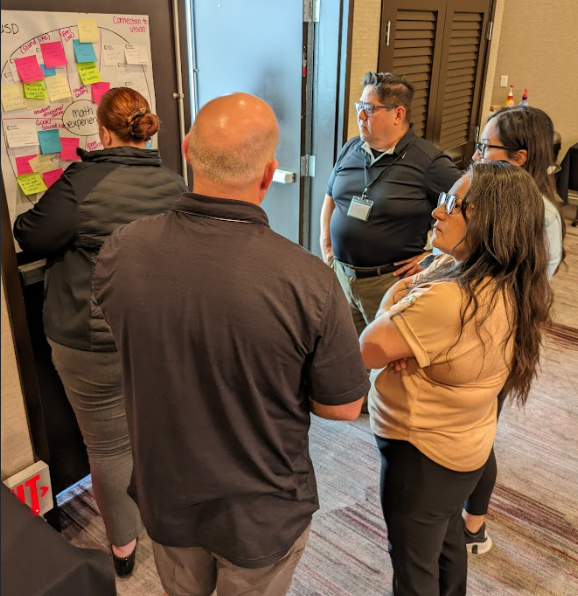Blog
Creating an Instructional Vision to Guide Your Math Materials Adoption Process
July 8, 2024

Takeaways from the 2024 CalCurriculum Math Workshop Series
My Experience Adopting Materials Without a Unified Vision
As a high school math teacher, I had a vision for my classroom: for all students to feel a sense of belonging and connection to see themselves as mathematicians. Through discourse, students work together to solve novel problems to see that mathematics is more about problem-solving and less about memorization. While I had my vision, I often worried that it might be different or disconnected from the approach of other teachers down the hall from me. We could all agree that we were “doing what is best for our students,” yet classrooms often looked, sounded, and felt very different. My classroom was full of discourse and group problem-solving; others were full of lectures and independent practice opportunities. We lacked a unified vision for math instruction.
During weekly professional learning communities (PLCs), it became abundantly clear to everyone that no one was entirely using the materials provided because they were not high-quality. Our materials did not authentically engage students in mathematical practices and rarely incorporated connections to students’ lives. As a result, we all searched for additional resources online or created our own materials, resulting in varying student mastery levels, engagement, and experiences from one classroom to the next.
When it was time to select a new high school math curriculum, we had a tremendous opportunity to improve the disparities we saw across our school. Unfortunately, our materials adoption process was guided less by data, engaging various educational partners, or an established instructional vision and more so by whoever had the loudest voice in the room. Ultimately, we selected two different instructional materials for the district. The loudest voice in the room used one set of materials that reflected their needs (focused on lecture and independent practice), and the rest of us agreed to a different set (centered on mathematical practices and opportunities for student discourse). This decision further exacerbated an existing challenge: the quality of math education varied from classroom to classroom.
While many districts have a mission, only some have a shared K–12 vision of what math education should look, sound, and feel like in their classrooms. My district was no exception. While our wider district mission called for all students to be college and career-ready, we were missing a unified vision for math instruction.
The Importance of An Instructional Vision When Selecting Materials
An instructional vision articulates what teaching and learning should look like in a particular content area. While standards name the specifics of what students should know and be able to do and instructional shifts within the standards describe the types of instruction the standards call for, an instructional vision is a district’s articulation of what students should experience daily and the overall goals for student learning. A clear vision for instruction should guide the adoption process and serve as a critical lens through which to view all potential materials.
Instructional visions act as the north star in the materials adoption process. Once set, they provide a clear guide to educators selecting and implementing new programs, particularly around non-negotiable components and key local priorities. Materials selected must help to support the instructional vision.
Instructional Visions and the 2024 CalCurriculum Math Workshop Series
Over the past four months, nine California school districts and charter management organizations (CMOs) have participated in a workshop series with the California Curriculum Collaborative. The series focused on adopting math instructional materials through the lens of the 2023 California Math Framework, and participants engaged in sessions to help build the foundation for their upcoming instructional materials adoption processes.
The importance of creating an instructional vision came up in every session. Throughout the workshop series, participants engaged in the development of a mathematics-specific instructional vision. A few takeaways from participating educators:
- Instructional visions need to be grounded in evidence and research. The 2023 CA Math Framework is a great resource for developing an instructional vision.
- Instructional visions are a shared understanding and a common language of what math instruction should be in your district. Creating the vision by including diverse voices and various educational partners (ELD specialists, special education educators, families, students, etc.) is crucial to ensuring it reflects the needs of all students.
- The instructional vision is the foundation for the material adoption process and ongoing professional learning opportunities, walk-through tools, and teacher evaluations.
- Instructional materials are just one of many tools to support the vision for math classrooms. Other critical components to support a district’s math vision include educator professional development, content area expertise, and a robust family engagement plan.


The Coachella Valley Unified School District team discusses their Instructional Vision for Mathematics.
I wish my district had been able to attend a workshop series like those provided by CalCurriculum. If we had an instructional vision to guide our work, it’s unlikely we would have ended up using two different math programs. Developing a research-based, content-specific instructional vision is the first step in creating math classrooms where all students can experience the joy, beauty, and wonder of mathematics.
You can learn how to create content-specific visions of instructional (including samples) and access guidance for their use during the materials adoption process. Creating an instructional vision is a step everyone can take now to prepare for upcoming math adoptions.